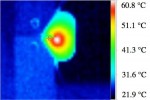Shape-memory polymer knows when it’s hurt, fixes itself

We’re no strangers to the futuristic catch-all idea of ‘ self-healing ‘ — it’s one of the basic tent poles of many conceptions of tomorrow. That said, researchers are currently hard at work at Arizona State on a material that — you guessed it — can detect when it is damaged and, of course, heal itself. Though we sound a bit incredulous, the science is pretty simple here, and the progress on the project is very real. The material uses what the researchers are calling ‘shape-memory’ polymers and have a fiber optic network embedded within them which acts as the damage sensor as well as the heat delivery system. The polymers return to a pre-defined shape when heated to a certain temperature, and, when damage is detected, an infrared laser sends light through the network to the damaged area, triggers the shape-memory, and commands the area to repair the crack or tear — regaining up to 96 percent of its original strength. The so-called autonomous adaptive structures are part of a long-term research into shape-memory healing which could impact long-term developments of implantable medical devices , for instance. A video of the shape recovery process is after the break. Continue reading Shape-memory polymer knows when it’s hurt, fixes itself Shape-memory polymer knows when it’s hurt, fixes itself originally appeared on Engadget on Fri, 10 Dec 2010 09:02:00 EDT. Please see our terms for use of feeds . Permalink

Posted by
on December 10, 2010. Filed under
News,
Tech.
You can follow any responses to this entry through the
RSS 2.0.
You can leave a response or trackback to this entry
Shape-memory polymer knows when it’s hurt, fixes itself

We’re no strangers to the futuristic catch-all idea of ‘ self-healing ‘ — it’s one of the basic tent poles of many conceptions of tomorrow. That said, researchers are currently hard at work at Arizona State on a material that — you guessed it — can detect when it is damaged and, of course, heal itself. Though we sound a bit incredulous, the science is pretty simple here, and the progress on the project is very real. The material uses what the researchers are calling ‘shape-memory’ polymers and have a fiber optic network embedded within them which acts as the damage sensor as well as the heat delivery system. The polymers return to a pre-defined shape when heated to a certain temperature, and, when damage is detected, an infrared laser sends light through the network to the damaged area, triggers the shape-memory, and commands the area to repair the crack or tear — regaining up to 96 percent of its original strength. The so-called autonomous adaptive structures are part of a long-term research into shape-memory healing which could impact long-term developments of implantable medical devices , for instance. A video of the shape recovery process is after the break. Continue reading Shape-memory polymer knows when it’s hurt, fixes itself Shape-memory polymer knows when it’s hurt, fixes itself originally appeared on Engadget on Fri, 10 Dec 2010 09:02:00 EDT. Please see our terms for use of feeds . Permalink


Posted by
on December 10, 2010. Filed under
News,
Tech.
You can follow any responses to this entry through the
RSS 2.0.
You can leave a response or trackback to this entry



